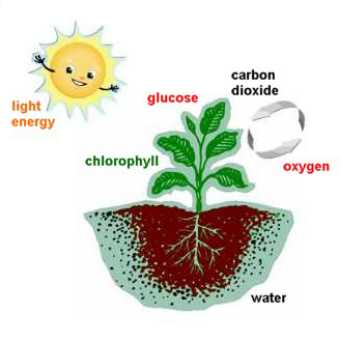
|
The process by which plants make food is called "photosynthesis". The word "photosynthesis" is made up of two words:
- "photo" = light
- "synthesis" = putting together
Chlorophyll is the green pigment found in plants. Both chlorophyll and light energy need to be present for photosynthesis to take place, but they are not used up in the process.
Thus, the process of photosynthesis can be represented as follows:
| carbon dioxide + water |
chlorophyll →→→→→→→→ light energy |
sugar (glucose) + oxygen |
Some of the sugar produced during photosynthesis is used by the plant for its life processes (such as growing and reproducing); the excess is converted mainly to starch and stored in various plant parts which may be used as food by animals and humans.
Oxygen produced during photosynthesis replenishes the oxygen that was used up by living things during respiration ... mouseover the above picture for more information on respiration.
This cycle of photosynthesis and respiration maintains the balance of carbon dioxide and oxygen on earth.
| Photosynthesis | Respiration |
| Occurs in the presence of light (and chlorophyll in plant cells) | Occurs at all times in cells |
| Requires energy (light) to make sugar (glucose) | Releases energy from sugar |
| Complex substances (sugar) are formed from simpler ones. | Complex substances (sugar) are broken down into simpler ones. |
| Carbon dioxide and water are the raw materials. | Carbon dioxide and water are the waste products. |
| Oxygen is given out. | Oxygen is taken in. |
| Photosynthesis & Respiration - McGraw-Hill G4 | Glencoe Online | |